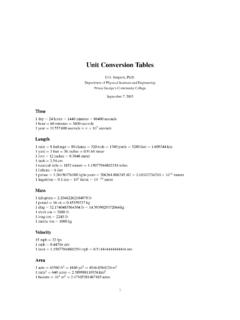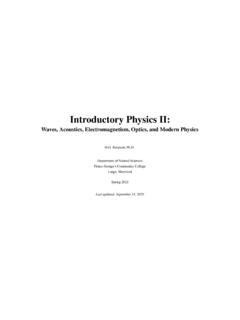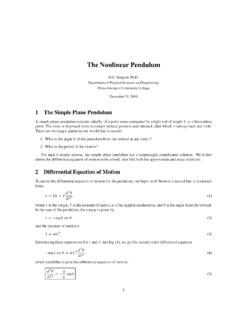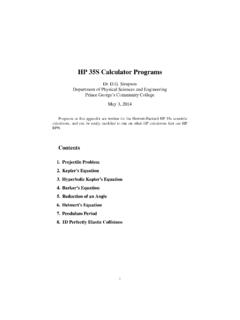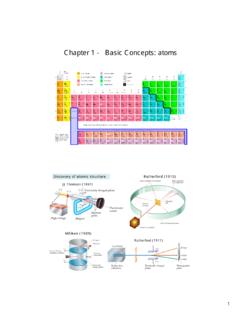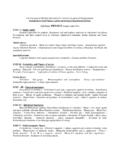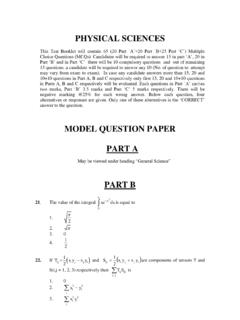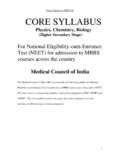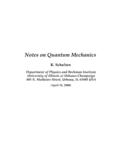Transcription of General Physics I - pgccphy.net
1 General Physics I: Classical Mechanics Simpson, Department of Physical Sciences and Engineering Prince George's Community College Largo, Maryland Fall 2014. Last updated: August 26, 2014. Contents Acknowledgments 10. 1 What is Physics ? 11. 2 Units 13. Systems of Units.. 13. SI Units .. 14. CGS Systems of Units .. 18. British Engineering Units .. 18. Units as an Error-Checking Technique .. 18. Unit Conversions .. 19. Currency Units.. 20. Odds and Ends .. 21. 3 Problem-Solving Strategies 22. 4 Density 24. Specific Gravity .. 25. Density Trivia .. 25. 5 Kinematics in One Dimension 27. Position .. 27. Velocity .. 27. Acceleration .. 28. Higher Derivatives .. 29. Dot Notation .. 29. Inverse Relations.. 29. Constant Acceleration .. 30. Summary .. 32. Geometric Interpretations .. 33. 6 Vectors 35. Introduction .. 35. Arithmetic: Graphical Methods .. 36. Arithmetic: Algebraic Methods .. 36. Derivatives.. 40. Integrals.
2 40. 1. Prince George's Community College General Physics I Simpson Other Vector Operations .. 40. 7 The Dot Product 42. Definition .. 42. Component Form .. 42. Properties .. 43. Matrix Formulation .. 44. 8 Kinematics in Two or Three Dimensions 46. Position .. 46. Velocity .. 46. Acceleration .. 46. Inverse Relations.. 47. Constant Acceleration .. 47. Vertical vs. Horizontal Motion .. 48. Summary .. 49. 9 Projectile Motion 51. Range .. 52. Maximum Altitude.. 53. Shape of the Projectile Path .. 54. Hitting a Target on the Ground.. 54. Hitting a Target on a Hill.. 56. Other Considerations .. 57. The Monkey and the Hunter Problem .. 57. Summary .. 59. 10 Newton's Method 60. Introduction .. 60. The Method .. 60. Example: Square Roots .. 60. Projectile Problem .. 62. 11 Mass 63. 12 Force 64. The Four Forces of Nature .. 64. Hooke's Law.. 65. Weight .. 65. Normal Force .. 65. Tension .. 65. 13 Newton's Laws of Motion 66.
3 First Law of Motion .. 67. Second Law of Motion.. 67. Third Law of Motion .. 67. 2. Prince George's Community College General Physics I Simpson 14 The Inclined Plane 68. 15 Atwood's Machine 69. 16 Statics 73. Mass Suspended by Two Ropes .. 73. The Pulley .. 76. The Elevator .. 76. 17 Friction 78. Introduction .. 78. Static Friction .. 78. Kinetic Friction .. 79. Rolling Friction .. 79. The Coefficient of Friction .. 79. 18 Resistive Forces in Fluids 81. Introduction .. 81. Model I: FR / v.. 81. Model II: FR / v 2 .. 83. 19 Circular Motion 86. Introduction .. 86. Centripetal Force .. 87. Centrifugal Force .. 88. Relations between Circular and Linear Motion.. 89. Examples .. 89. 20 Work 90. Introduction .. 90. Case I: Constant F k r .. 90. Case II: Constant F r .. 91. Case III: Variable F k r .. 91. Case IV ( General Case): Variable F r .. 91. Summary .. 92. 21 Energy 93. Introduction .. 93. Kinetic Energy .. 93.
4 Potential Energy .. 94. Other Forms of Energy.. 97. Conservation of Energy .. 97. The Work-Energy Theorem .. 98. The Virial Theorem .. 98. 22 Conservative Forces 100. 23 Power 101. Energy Conversion of a Falling Body .. 101. 3. Prince George's Community College General Physics I Simpson Rate of Change of Power .. 102. Vector Equation .. 103. 24 Linear Momentum 104. Introduction .. 104. Conservation of Momentum .. 104. Newton's Second Law of Motion .. 104. 25 Impulse 106. 26 Collisions 108. Introduction .. 108. The Coefficient of Restitution .. 108. Perfectly Inelastic Collisions.. 109. Perfectly Elastic Collisions .. 109. Newton's Cradle .. 111. Inelastic Collisions.. 112. Collisions in Two Dimensions .. 112. 27 The Ballistic Pendulum 114. 28 Rockets 116. Introduction .. 116. The Rocket Equation.. 116. Mass Fraction .. 117. Staging .. 118. 29 Center of Mass 119. Introduction .. 119. Discrete Masses .. 119. Continuous Bodies.
5 120. 30 The Cross Product 123. Definition .. 123. Component Form .. 124. Properties .. 124. Matrix Formulation .. 126. Inverse .. 126. 31 Rotational Motion 128. Introduction .. 128. Translational vs. Rotational Motion .. 128. Example Problems .. 130. 32 Moment of Inertia 132. Introduction .. 132. Parallel Axis Theorem .. 136. Plane Figure Theorem .. 138. Routh's Rule .. 138. 4. Prince George's Community College General Physics I Simpson Lees' Rule .. 138. 33 Torque 140. Introduction .. 140. Rotational Versions of Newton's Laws .. 141. Rotational Version of Hooke's Law .. 141. 34 The Pendulum 142. Introduction .. 142. The Simple Plane Pendulum .. 142. The Spherical Pendulum .. 143. The Conical Pendulum.. 143. The Torsional Pendulum .. 145. The Physical Pendulum .. 145. Other Pendulums .. 147. 35 Simple Harmonic Motion 148. Energy .. 150. Frequency and Period .. 152. Mass on a Spring .. 152. 36 Rolling Bodies 154.
6 Introduction .. 154. Velocity .. 154. Acceleration .. 155. Kinetic Energy .. 156. The Wheel .. 157. Ball Rolling in a Bowl .. 158. 37 Galileo's Law 160. Introduction .. 160. Modern Treatment .. 160. 38 The Coriolis Force 162. Introduction .. 162. Examples .. 163. 39 Angular Momentum 164. Introduction .. 164. Conservation of Angular Momentum .. 164. 40 Conservation Laws 166. 41 The Gyroscope 167. Introduction .. 167. Precession .. 167. Nutation .. 168. 5. Prince George's Community College General Physics I Simpson 42 Roller Coasters 169. General Principles .. 169. Loop Shapes .. 169. 43 Elasticity 170. Introduction .. 170. Longitudinal (Normal) Stress .. 170. Transverse (Shear) Stress Translational .. 171. Transverse (Shear) Stress Torsional .. 172. Volume Stress .. 172. Elastic Limit .. 173. Summary .. 173. 44 Fluid Mechanics 174. Introduction .. 174. Archimedes' Principle .. 174. Floating Bodies .. 174. Pressure.
7 175. Change in Fluid Pressure with Depth .. 176. Pascal's Law .. 177. Fluid Dynamics .. 177. The Continuity Equation .. 178. Bernoulli's Equation .. 178. Torricelli's Theorem .. 179. The Siphon .. 180. Viscosity.. 182. The Reynolds Number .. 184. Stokes's Law.. 184. Fluid Flow through a Pipe .. 185. Superfluids.. 185. 45 Hydraulics 188. The Hydraulic Press .. 188. 46 Pneumatics 190. 47 Gravity 191. Newton's Law of Gravity .. 191. Gravitational Potential .. 191. The Cavendish Experiment .. 192. Helmert's Equation .. 192. Escape Velocity .. 193. Gauss's Formulation .. 193. General Relativity .. 197. Black Holes .. 198. 6. Prince George's Community College General Physics I Simpson 48 Earth Rotation 199. Introduction .. 199. Precession .. 199. Nutation .. 199. Polar Motion.. 201. Rotation Rate .. 201. 49 Geodesy 203. Introduction .. 203. The Cosine Formula .. 203. Vincenty's Formul : Introduction .. 204. Vincenty's Formul : Direct Problem.
8 204. Vincenty's Formul : Inverse Problem .. 206. 50 Celestial Mechanics 209. Introduction .. 209. Kepler's Laws .. 209. Time .. 210. Orbit Reference Frames .. 210. Orbital Elements .. 211. Right Ascension and Declination .. 212. Computing a Position .. 213. The Inverse Problem .. 214. Corrections to the Two-Body Calculation .. 214. Bound and Unbound Orbits .. 215. The Vis Viva Equation .. 215. Bertrand's Theorem .. 216. Differential Equation for an Orbit .. 216. Lagrange Points .. 217. The Rings of Saturn .. 218. Hyperbolic Orbits .. 220. Parabolic Orbits .. 221. 51 Astrodynamics 222. Circular Orbits .. 222. Geosynchronous Orbits .. 224. Elliptical Orbits .. 225. The Hohmann Transfer .. 228. Gravity Assist Maneuvers .. 229. The International Cometary Explorer .. 231. 52 Partial Derivatives 233. First Partial Derivatives .. 233. Higher-Order Partial Derivatives .. 234. 53 Lagrangian Mechanics 235. Examples.
9 236. 7. Prince George's Community College General Physics I Simpson 54 Hamiltonian Mechanics 238. Examples .. 238. 55 Special Relativity 241. Introduction .. 241. Postulates .. 241. Time Dilation .. 241. Length Contraction .. 242. An Example .. 242. Momentum .. 242. Addition of Velocities .. 243. Energy .. 243. 56 Quantum Mechanics 245. Introduction .. 245. Review of Newtonian Mechanics .. 245. Quantum Mechanics .. 245. Example: Simple Harmonic Oscillator.. 247. The Heisenberg Uncertainty Principle .. 248. A Further Reading 250. B Greek Alphabet 254. C Trigonometry 255. D Useful Series 259. E SI Units 260. F Gaussian Units 263. G Units of Physical Quantities 265. H Physical Constants 268. I Astronomical Data 269. J Unit Conversion Tables 270. K Angular Measure 274. Plane Angle .. 274. Solid Angle .. 274. L Vector Arithmetic 276. M Matrix Properties 279. N Newton's Laws of Motion (Original) 281. 8. Prince George's Community College General Physics I Simpson O The Simple Plane Pendulum: Exact Solution 282.
10 Equation of Motion .. 282. Solution, .t/ .. 283. Period .. 283. P Motion of a Falling Body 287. Q Table of Viscosities 289. R Calculator Programs 291. S Round-Number Handbook of Physics 292. T Fundamental Physical Constants Extensive Listing 294. U Periodic Table of the Elements 301. References 301. Index 305. 9. Acknowledgments The author wishes to express his thanks to his father, Simpson, for valuable comments on and help with the material on resistive forces in fluids and fluid mechanics. 10. Chapter 1. What is Physics ? Physics is the most fundamental of the sciences. Its goal is to learn how the Universe works at the most fundamental level and to discover the basic laws by which it operates. Theoretical Physics concentrates on developing the theory and mathematics of these laws, while applied Physics focuses attention on the application of the principles of Physics to practical problems. Experimental Physics lies at the intersection of Physics and engineering; experimental physicists have the theoretical knowledge of theoretical physicists, and they know how to build and work with scientific equipment.
